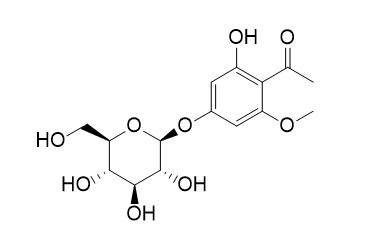Annphenone
Annphenone exhibits antioxidant properties by inhibiting ROS generation and thus protecting cells from H2O2-induced cell damage.
Inquire / Order:
manager@chemfaces.com
Technical Inquiries:
service@chemfaces.com
Tel:
+86-27-84237783
Fax:
+86-27-84254680
Address:
1 Building, No. 83, CheCheng Rd., Wuhan Economic and Technological Development Zone, Wuhan, Hubei 430056, PRC
Providing storage is as stated on the product vial and the vial is kept tightly sealed, the product can be stored for up to
24 months(2-8C).
Wherever possible, you should prepare and use solutions on the same day. However, if you need to make up stock solutions in advance, we recommend that you store the solution as aliquots in tightly sealed vials at -20C. Generally, these will be useable for up to two weeks. Before use, and prior to opening the vial we recommend that you allow your product to equilibrate to room temperature for at least 1 hour.
Need more advice on solubility, usage and handling? Please email to: service@chemfaces.com
The packaging of the product may have turned upside down during transportation, resulting in the natural compounds adhering to the neck or cap of the vial. take the vial out of its packaging and gently shake to let the compounds fall to the bottom of the vial. for liquid products, centrifuge at 200-500 RPM to gather the liquid at the bottom of the vial. try to avoid loss or contamination during handling.
New Zealand J. Forestry Sci.2014, 44:17
J Appl Microbiol.2022, 132(2):949-963.
Int J Mol Sci.2021, 22(19):10220.
Revista Brasileira de Farmacognosia2024, 34:1091-1100.
Mol Med Rep.2014, 9(5):1653-9
The Journal of Korean Medicine2022, 43(3): 79-93.
Plant Physiol Biochem.2023, 201:107795.
Int. J. Mol. Sci.2022, 23(19), 11900.
Pharmacological Reports2020, 1-9
South African J of Plant&Soil2018, 29-32
Related and Featured Products
Cell Biol Int. 2008 Sep;32(9):1099-1107.
Cytoprotective activity of annphenone against oxidative stress-induced apoptosis in V79-4 lung fibroblast cells[Pubmed:
18550394]
We have elucidated the cytoprotective effect of Annphenone (2,4-dihyroxy-6-methoxy-acetophenone 4-O-beta-D-glucopyranoside) against oxidative stress-induced apoptosis. Annphenone scavenged intracellular reactive oxygen species (ROS) and increased antioxidant enzyme activities. It thereby prevented lipid peroxidation and DNA damage, which was demonstrated by the inhibition of the formation of thiobarbituric acid reactive substance (TBARS), inhibition of the comet tail and decreased phospho-H2A.X expression. Annphenone protected Chinese hamster lung fibroblast (V79-4) cells from cell death via the inhibition of apoptosis induced by hydrogen peroxide (H2O2), as shown by decreased apoptotic nuclear fragmentation, decreased sub-G1 cell population and inhibited mitochondrial membrane potential (Deltapsi) loss. Taken together, these findings suggest that Annphenone exhibits antioxidant properties by inhibiting ROS generation and thus protecting cells from H2O2-induced cell damage.
Zhongguo Zhong Yao Za Zhi . 2021 Mar;46(5):1160-1167.
[Research on chemical constituents from Artemisia annua Ⅰ][Pubmed:
33787111]
Chemical constituents were isolated and purified from the water extract of Artemisia annua by column chromatography of HP-20 macroporous resin, silica gel, ODS, Sephadex LH-20, HW-40, and semi-preparative RP-HPLC. Their structures were elucidated by physicochemical properties and spectral analyses. As a result, Fifteen compounds were isolated and identified as vitexnegheteroin M(1), sibricose A5(2), securoside A(3), citrusin D(4), Annphenone(5), E-melilotoside(6), esculetin(7), scopoletin-7-O-β-D-glucoside(8), eleutheroside B_1(9), chrysosplenol D(10), patuletin-3-O-β-D-glucopyranoside(11), quercetin-7-O-β-D-glucoside(12), rutin(13), apigenin 6,8-di-C-β-D-glucopyranoside(14), isoschaftoside(15), among them, compounds 1-4 were identified from Artemisia for the first time. Additionally, the isolates were evaluated for their inhibitory effects on the production of PGE_2 in LPS-simulated RAW264.7 macrophages. The results showed that compounds 1, 2, 8, and 10-15 could reduce PGE_2 levels, to a certain extent.
Zhongguo Zhong Yao Za Zhi . 2021 Mar;46(5):1160-1167.
[Research on chemical constituents from Artemisia annua Ⅰ][Pubmed:
33787111]
Chemical constituents were isolated and purified from the water extract of Artemisia annua by column chromatography of HP-20 macroporous resin, silica gel, ODS, Sephadex LH-20, HW-40, and semi-preparative RP-HPLC. Their structures were elucidated by physicochemical properties and spectral analyses. As a result, Fifteen compounds were isolated and identified as vitexnegheteroin M(1), sibricose A5(2), securoside A(3), citrusin D(4), Annphenone(5), E-melilotoside(6), esculetin(7), scopoletin-7-O-β-D-glucoside(8), eleutheroside B_1(9), chrysosplenol D(10), patuletin-3-O-β-D-glucopyranoside(11), quercetin-7-O-β-D-glucoside(12), rutin(13), apigenin 6,8-di-C-β-D-glucopyranoside(14), isoschaftoside(15), among them, compounds 1-4 were identified from Artemisia for the first time. Additionally, the isolates were evaluated for their inhibitory effects on the production of PGE_2 in LPS-simulated RAW264.7 macrophages. The results showed that compounds 1, 2, 8, and 10-15 could reduce PGE_2 levels, to a certain extent.



